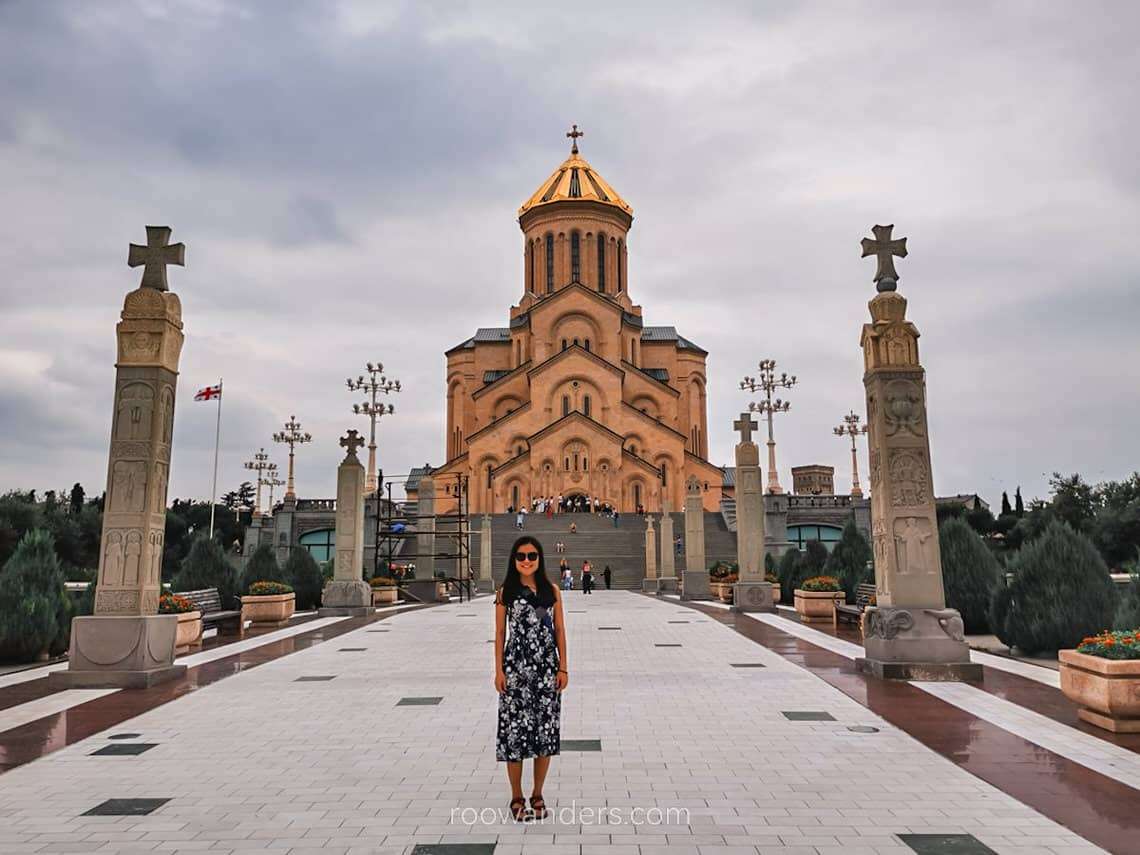
Guide to Exploring Tbilisi, Georgia
Tbilisi, the capital of Georgia, is a wonderful city to visit. A mix of old and new.
I’ve planned to visit the Caucasus ever since I saw the photos of the dreamy mountains of Svaneti in Georgia, the grand monastery and fortresses of Armenia, and the intricate mosques and landscape of Azerbaijan.
However, with just two weeks to spare – I have a full-time job! – and dreams of trekking in the mountainous region of Svaneti and visiting the landlocked exclave of Nakhchivan, I could only choose to visit two countries.
Digression aside, what’s there to see and do in Tbilisi – the city where most travellers to this beautiful country would land? Let’s go!

I visited the Caucasus in Aug 2019. This post contains affiliate links that cost nothing to you but support my blog! It may also be updated periodically. Cheers!
Brief Background of Tbilisi
Tbilisi was founded in the 5th century by King Vakhtang I Gorgasali when he was out hunting in the woods. The King had a falcon, which spotted a pheasant and went in for the kill. However, both birds fell into a hot spring during the struggle and died instantaneously.
Sounds morbid, but that was how the hot spring was discovered and how the King was so impressed (he might have been cold from the frigid winter) that he decided to build his empire in Tbilisi.
The name Tbilisi – translated as the warm place in Georgian – stuck and remained ever since then. Hence, you could say the history of sulphur baths is the history of Tbilisi itself. Make sure you visit one while in Tbilisi!
Between then and the 1783 treaty of Georgievsk when it came under the Russians, Tbilisi was sacked and conquered multiple times from all sorts of invaders – the Turks, the Persians, the Arabs, and the Mongols, to name a few.
Under Russian influence, Tbilisi adopted more Western/ European culture, leaving behind the more Eastern/ Persian styles. Nevertheless, new infrastructures and amenities sprung up despite the world wars, civil unrest and protests.
Georgia gained its independence on 26 May 1991 with the fall of the Soviet Union. Its capital city, Tbilisi, is now a cultural and educational hub, featuring a university and several institutions of higher education. It is also a growing travel destination for its safety, variety of attractions and affordability. The year-long visa-free option for several countries helped a lot as well.
Best Time to visit Tbilisi
Georgia has four seasons, so there isn’t a so-called best time, as it depends on what you want to see and achieve on your visit.
I visited in August when the weather felt Goldilocks-just-nice for me coming from warm and humid Singapore. The mountains in Svaneti were perfect for hiking too.
Generally, if you hate the cold as much as the King and are trying to skip the winter months of Dec – Feb, and the transition period before and after that, visit Tbilisi around May to September.
But if you don’t want too many crowds or too much heat, then aim for June.
And if it is the dreamy snowy landscape you’d like to see, go for Dec – Feb. This period is also prime time up in the ski resorts. You would most likely enjoy your hot spring soak very much as well.
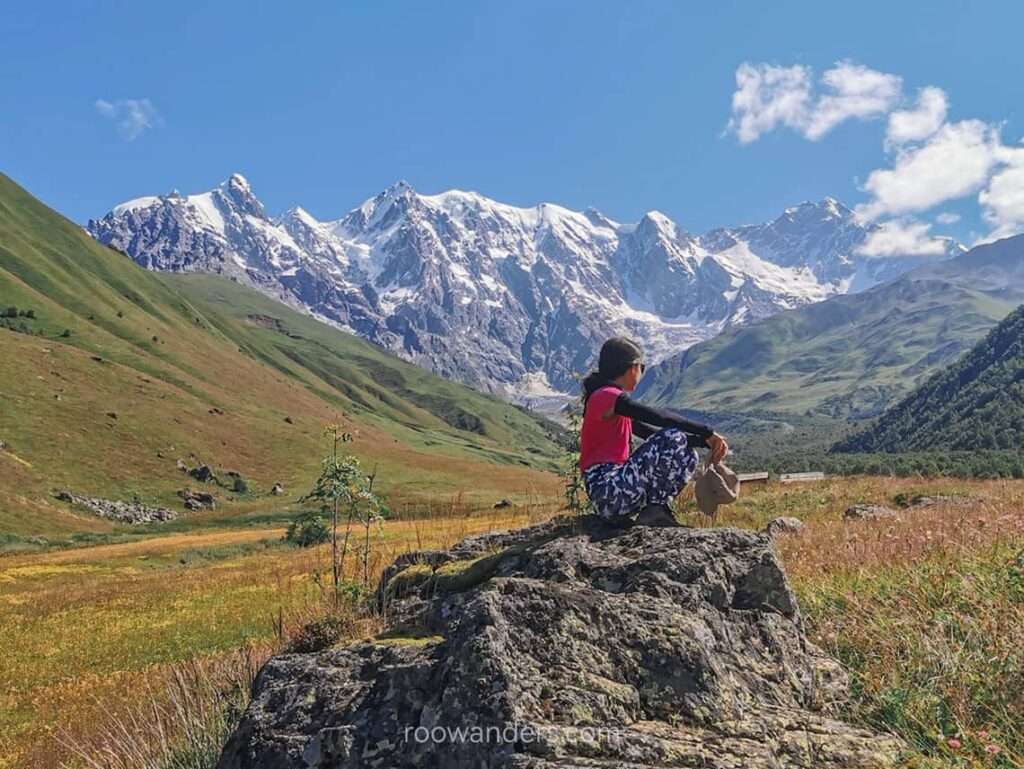
Getting to Tbilisi
Georgian Visa
If you’re a Singaporean, rejoice! There’s no need to apply for a visa with our red passport!
But then again, Georgia is a generous country and offers visa-free visits to plenty of countries. And by generosity, it is visa-free for ONE YEAR – very good news for digital nomads!
Flight
Tbilisi has an international airport 30 – 40 minutes from the city centre. I flew from Singapore to Tbilisi with a transit in Dubai.
The majority of the direct flights into Tbilisi hail from Europe. Dubai and Doha are the most popular transit stops for travellers from the East. Check for your best flights to Tbilisi here!
There are also domestic flights from other cities of Georgia to Tbilisi, like Mestia, Batumi and Ambrolauri operated by local brand Vanillasky.
However, instead of landing in (or heading to) Tbilisi International Airport, know that these planes operate exclusively from the domestic Natakhtari Airfield, about 30 minutes from the city centre. Book your flights early as these planes are usually very popular. As the planes are small, they may also be cancelled on short notice due to unforeseeable weather conditions that are common in the mountains.
Train
As a landlocked country at the intersection of the East and West, Tbilisi is well supported by international trains from neighbouring Turkiye, Armenia, Azerbaijan and Russia.
For my Cacausus trip, I took a night train from Tbilisi to Baku, Azerbaijan. More about the train on a separate post, but know that you can buy your train tickets in advance from 12Go, which is where I’d usually head over to solve my transport needs.
Within Georgia, I’ve also taken the night train from Tbilisi to Zugdidi, the gateway to Svaneti and the mountains. You could also take the trains to visit other towns and cities in Georgia from Tbilisi, like Batumi, Kutaisi and Vardzia.
Thinking about hiking in Georgia? Well, you could DIY a multi-day trek without camping gear like I did here. The walk was breathtaking – literally and figuratively.
Bus
As with other big countries, international and domestic buses bring you from the neighbouring countries or other Georgian cities to Tbilisi, or vice versa. For instance, night buses from Batumi, the Black Sea resort city of Georgia, to Tbilisi, and morning rides from Yerevan, the capital of Armenia, to Tbilisi.
Buses are pocket-friendly for the budget-conscious backpackers, though time-sensitive folks might consider flights instead. You can browse for your preferred mode of transport and timing here.

Travelling within Tbilisi
Tbilisi has a relatively extensive metro and bus system that covers the entire city and costs a flat 1 GEL, regardless of your length of travel. You can transfer between metro and buses within their 90-minute grace period, but still have to tap in to board the bus or metro.
In the past pre-pandemic time when I visited Tbilisi, passengers could still use cash to board the bus or buy a single token to use the metro. Fees used to be 0.5 GEL. However, the city has since upgraded its transport system, and cash is no longer accepted. As with Singapore, you buy and charge a transport card, in this case, the MetroMoney Card, own an unlimited Travel Card or use a contactless pay method to board their public transport.
Cost and convenience-wise, however, I’d still choose to hail a ride through one of their operators – Bolt or Yandex – to get out of the airport.
MetroMoney Card
The MetroMoney card is the old travel card used in Tbilisi to board buses, use the metro, and board the Narikala Cable Car.
It is rechargeable and available at any cash desk within the metro stations, the Narikala Cable Car station, and in the airport for 2 GEL. Keep your receipt to refund your deposit of the card within 30 days of activation at any cash desk.
Travel Card
Unlike the MetroMoney cards, Travel Cards are sold in various time frames, ranging from a day to a year for varying prices starting from 3 GEL, on top of the 2 GEL for the physical card. It entitles the passenger to unlimited rides during the purchased period and includes the metro and all buses. This is the best cost-efficient option for long-stay digital nomads!
You do not need an ID to purchase the cards from any metro stations or banks, but you do need to note that the cards cannot be shared with other passengers on the same journey.
Metro
The metro in Tbilisi runs everyday from 6 AM to midnight. It is self-explanatory, and a ride costs a flat 1 GEL via the MetroMoney card.
Bus
Generally, Google Maps should suffice to get you around Tbilisi without much problem. Timings in the metro are punctual and often, whereas buses are highly dependent on traffic conditions.
If you’d like to check the bus routes and timetables, the Tbilisi Transport Company (TTC) has developed an app to help you with that.
Private Hire/ Taxi
My stay in Tbilisi was short, and I mostly got around the city by private hire or walking.
Always book your taxi ride through their app – Yandex or Bolt – and double check on their car plate number before getting in.
Things to do in Tbilisi
Eat away!
The food and wine I had in Georgia were so memorable and delicious that I still think about them. Most of them are the stew or soupy kind, which I adore to no end, making Georgia one of my favourite countries for food.
Fingers crossed, I’d be back soon to indulge in them again, or maybe I’d cook my own Georgian-inspired stews and soups instead until my return to Georgia! Meanwhile, here are some traditional foods to try in Tbilisi or anywhere in Georgia.

Khinkali: Dumpling
Khinkalis are Georgian soup dumplings that reminded me of Xiao Long Bao 小籠包 in Chinese dim sum. Xiao Long Baos and Khinkalis are doughs with a meaty mixture inside surrounded by its delicious meaty soup. You suck the sweet meat juice out from both dumplings via the top opening before taking the first bite.
Unlike the delicate Xiao Long Baos, Khinkalis are bigger with tougher dough skin that does not break as easily.
Khachapuri: Cheese Bread
Khachapuri, the national dish of Georgia, is an open-faced cheese-filled bread baked with an egg. This visually appealing savoury baked good is a delightful way to awaken my body in the morning as breakfast – especially when served warm – with a delicious cup of coffee.
Churchkhela: Sweet Snack
Churchkhela is a traditional Georgian candle or sausage-shaped sweet made from grape must, nuts and flour. They are sweet and chewy and excellent to bring home as souvenirs.
I brought back a few strings of Churchkhela to the curiosity of my friends and family.

Ajapsandali: Eggplant Stew
Ajapsandali is a comforting eggplant stew cooked to perfection, best devoured with crisp bread. You cannot despise mushy, delicious eggplant.
Lobio: Bean Stew
Lobio is a Georgian bean stew with lots of earthy herbs and spices. The best Lobio I had eaten was at a guesthouse in Svaneti – might have been due to a long day of trekking in the Caucasus.

Mtsvadi: Meat Skewer
Mtsvadi is Georgian meat skewers grilled or BBQ-ed, somewhat like the kebab.
Lobiani: Bean Bread
Lobiani is bread filled with beans, great as snacks or lunch while hiking.
Tolma: Wrapped Meat
Tolma are meat concoctions wrapped in cabbage leaves. They are similar to the Turkish Dolma, except cabbage leaves, as opposed to grape leaves, are used, so their texture is softer, and their size is larger.
Kharcho: Meaty Rice Soup
Kharcho or Harcho is a comforting bowl of beef or lamb rice soup.
Chakapuli: Lamb Tarragon Stew
Chakapuli mainly uses lamb, tarragon, white wine, and this special green Tkemali or plum sauce.
Wine and Beer
Sorry folks! I’m not a wine enthusiast or a beer buff. Rather, I am an alcoholic opportunist and order a glass or a pint only when it is affordable, for social causes, or when it is a must-do thing in the place I’m visiting.
Enjoying wine is a must-do in Georgia, which may be the birthplace of wine. The people here have enjoyed wine for thousands of years, so they must have perfected the art of wine-making. Their traditional way of making wine in qvevris is also listed in UNESCO.
Coming from expensive Singapore, where alcohol is heavily taxed, imported wine is exorbitant! And so, I had a good time ordering red wine or beer – delicious after a day of long walk – for most of my meals while I was in Georgia.
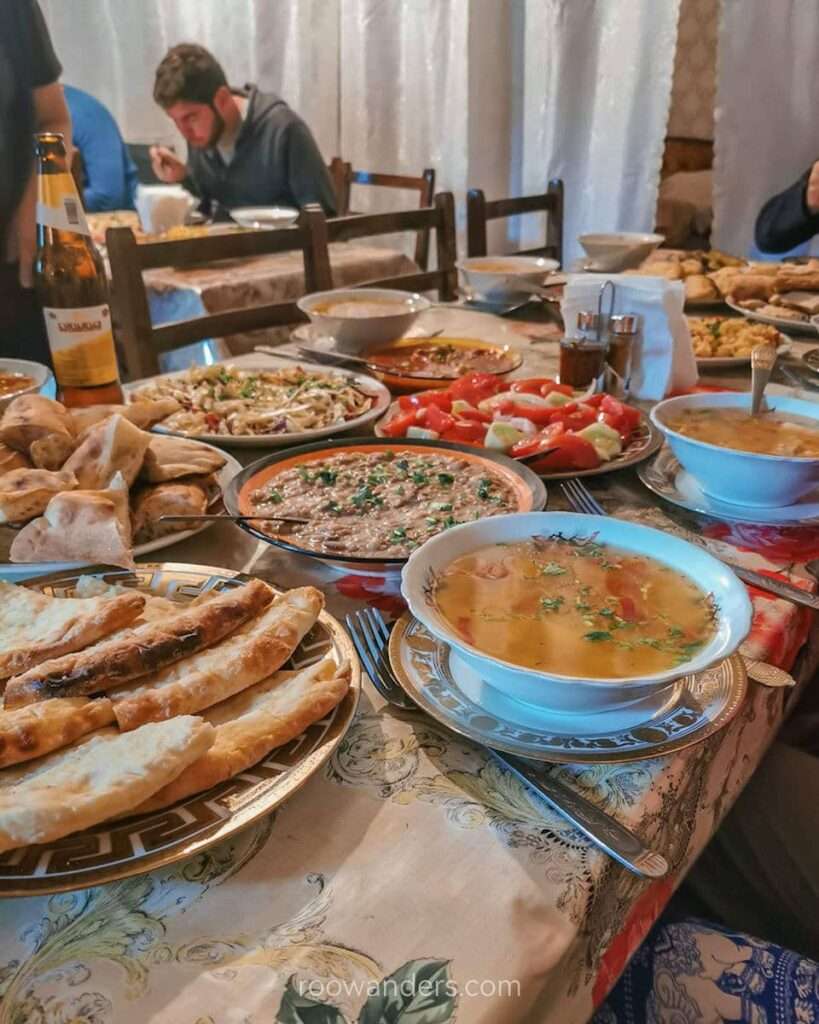
Learn more about Tbilisi with a free walking tour
Explore Tbilisi Old Town by foot with this group of time-generous and informative local guides. Since I did very little homework beforehand, following the guide helped me understand and appreciate the city better.
Buffer at least 3 hours for the walk, and tip them well! Their walks begin at 12pm. Online reservations are required.
Tbilisi Free Walking Tours group also offers affordable wine-tasting and food-tasting walking tours.


Enjoy a soothing sulphur hot spring soak
Coming up next, apart from hearty stews, soups and old town walks, we have the warm soak. The sulphur hot springs are mainly clustered within the area of Abanotubani.
As mentioned, Tbilisi was named after the warm waters that sprouted underground. There are plenty of sulfur baths – private and public – to choose from in Tbilisi. I’ve written a ✨detailed✨ guide and my experience here for your curious perusal!
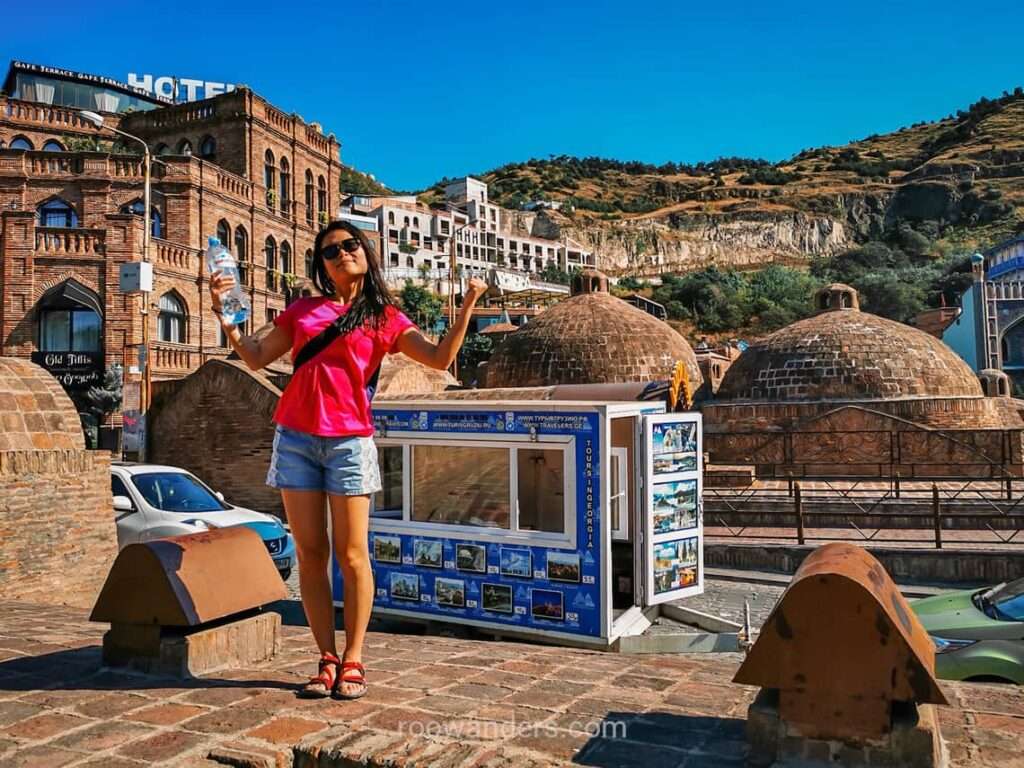
Spot the Falcon and Pheasant sculpture
Situated within the cluster of dome-shaped sulfur baths, the sculpture is an illustration depicting the origin of Tbilisi.
Tbilisi is old, and one can easily forget the city’s origin and age from the modern buildings around it. I thought the sculpture of the two birds apt in reminding people of the city’s roots.
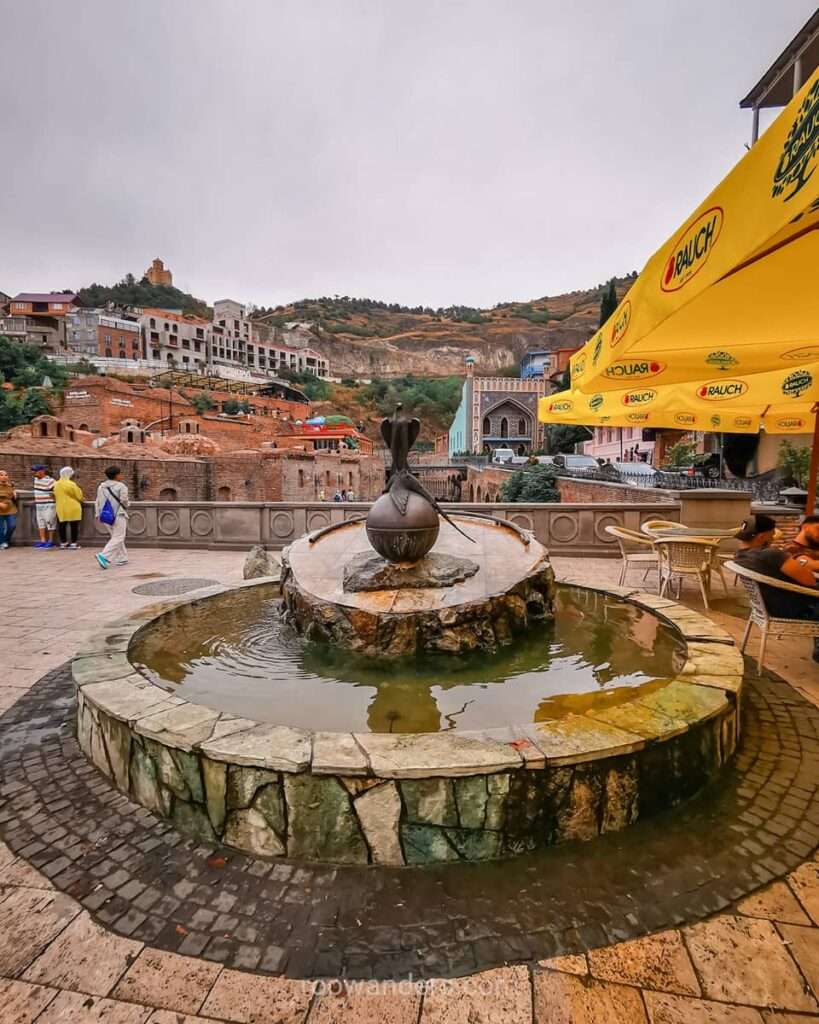
Cross the Love Lock Bridge
Also known as the Lovers’ Bridge, this bridge, located within the cluster of sulfur baths, is a landmark that makes for some pretty photos surrounded by brick houses, tenacious wall plants and jutting balconies with peeling paints atop the Leghvtakhevi Canyon.
Similar to the many Love Lock Bridges of the world, sentimental couples lock a lock on this bridge to lock their eternal love. I wouldn’t subscribe to this practice – maybe I’m not as romantic – as too many locks can topple the bridge. 😅

Walk to the hidden waterfall
Wander past the love bridge, following the path set by the canyon to reach the dead end, where a beautiful waterfall sprouts.
Leghvtakhevi Waterfall is such a charming and strange waterfall in the old town of Tbilisi. Charming for old-town vibes and wonders. Strange for having a waterfall and the canyon it has carved within walking distance from a city.
The 22 m tall cascade flows from the Tsavkisistskali River, and bypasses the Botanical Garden, before merging with the Mtkvari/ Kura River.

Catch the daily show from the Leaning Clock Tower
The Leaning Clock Tower of Old Tbilisi is such a fun sight!
Designed by the renowned Georgian puppeteer Rezo Gabriadze, the clock tower also houses the smallest clock in Georgia and an actual running theatre.
Catch the angel hitting the bell at the hour.


Shop at the Meidan Bazar
Or window-shop as this bazaar is actually quite touristy.
Then again, most bazaars or marketplaces that are highly rated in cities I’ve visited are touristy. Thenx2 again, it is fun to walk through this underground brick tunnel marketplace, feel the vibe, and window shop the trinkets and items on stock. Perhaps something might catch your eye.
Snap a photo with the ‘I Love Tbilisi’ sign
Most cities have a ‘I Love *name of city*’ sign or *the name of the city* sign sitting somewhere. Exception: I don’t think I’ve seen one in Singapore.
I don’t know about you, but I’d like to snap a photo of one, preferably with me morphed in between the letters, if I see it around.
The ‘I Love Tbilisi’ sign is in front of a restaurant near Meidan Bazar tunnel market.

Marvel at the monument of King Vakhtang Gorgasali
As you walk out of Meidan Bazar towards Rike Park, you’re bound to come face to face with the stately King Vakhtang Gorgasali statue. As with Vientiane in Laos with their stately statue of King/ Chao Anouvong, the city’s founder, here on the other side of the world, we have the King and founder of Tbilisi on his horse, proudly facing the old town.
The statue of the King sits within the compound of Metekhi Church, one of the oldest churches in Tbilisi, said to have been built in the 12th century. Interestingly, the first King built his residence and made Tbilisi his capital on that same hill many centuries before. Another King later built the church on that strategic spot hundreds of years later.

Wander through the Holy Trinity Cathedral of Tbilisi
On the other side of the river bank lies a monumental cathedral within walking distance from the equestrian statue of the King.
The Holy Trinity Cathedral of Tbilisi is such a delight, not just to the eyes for its grand size and ample space, but also for the serenity it commands.
Also known as Sameda Cathedral, the cathedral is the biggest place of worship in Georgia and one of the largest Orthodox cathedrals in the world!
Have a shawl ready or be properly attired before entering the religious and sacred ground.
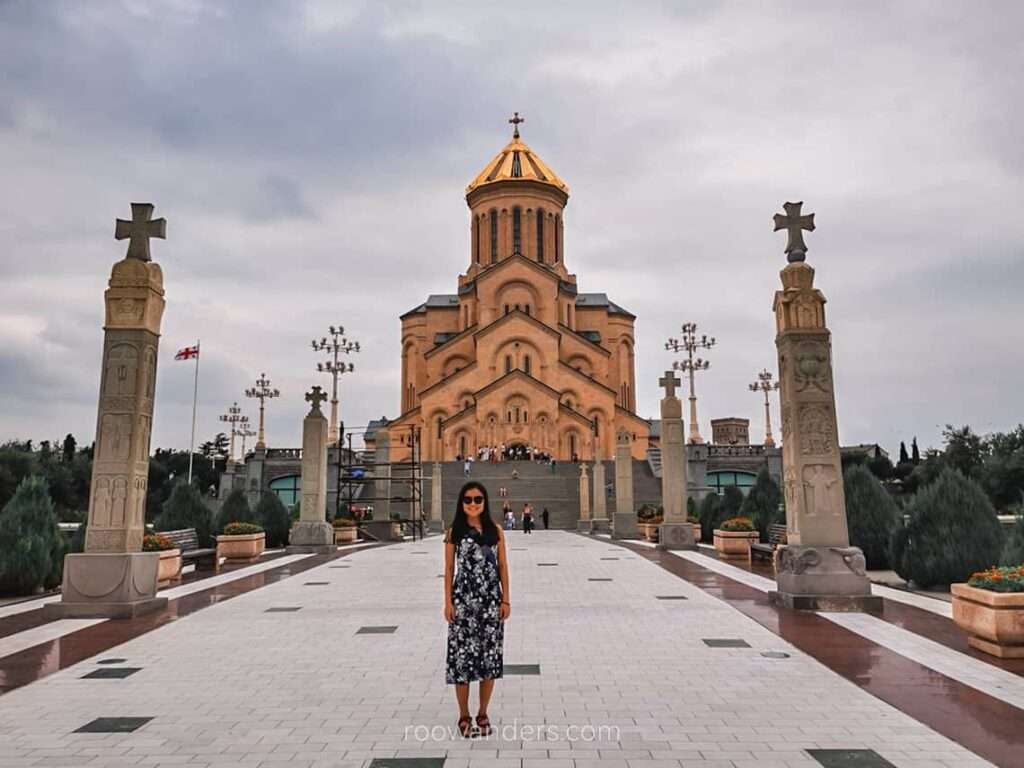
Dance through The Bridge of Peace
The image of The Bridge of Peace features prominently in the cityscape of pretty much every bird’s eye photo I’ve seen of Tbilisi.
Designed by an esteemed Italian architect Michele De Lucch, the bridge is like a sleek modern creature stretched over the Mtkvari/ Kura River, sitting amidst the historic surroundings of Tbilisi. It looks exceptionally beautiful at night when viewed from a vantage point like the Narikala Fortress, with the undulating LED displays.
Locals have, however, drawn a resemblance to a maxi-pad, hence have given it the nickname Always Ultra.

Take a cable car ride
For 2.5 GEL for a one-way trip from Rike Park to Narikala Fortress, this cable car ride will probably be the cheapest I’ve ever ridden. Except the queue to get into one at Rike Park was too long for me then.
I could imagine the ride over the charming Mtkvari/ Kura River and Tbilisi terracotta rooftops to be breathtaking – even more so during winter with snow peppered over the roofs, or during the golden moments during sunset with the river’s reflection!
The cable car is extremely popular owing to its affordability and convenience of accessing Narikala Fortress without the hike. Service is available all year round from 10 AM till 10 PM. You’d need a MetroMoney card to make payment. The card can be charged with money for bus and metro services.
Climb the Narikala Fortress
If you score the 5-minute cable ride up to Narikala Fortress, great job. If not, buffer about 20 minutes to walk up to the fortress from Old Town, which isn’t too bad and gives you a great workout!
There are two routes to walk from the Old Town: (1) via Orbiri Street from Abanotubani where the sulphur baths are, or (2) the Betlemi Street Stairs from Lado Asatiani Street. I did the first one, and the views were great as we climbed.
As with any empire, Narikala Fortress was built atop the most favourable vantage point overlooking the bustling town/ city. The ancient castle had seen numerous developments in Tbilisi city. It went from the hands of one conqueror to the next, with each expanding or adding fortifications atop the original.
What remains now are crumbling ruins with areas that allow for climbing for better views of Tbilisi City and a comparatively new – recently restored in 1996 – St Nicholas Church.
Visiting Narikala Fortress is free, and it is open 24/7. Incorporate your visit with the 1500 m trail demarcated with other attractions on the hill, including Mother of Georgia and the Botanical Gardens.

Visit the Mother of Georgia statue
I like ingenious symbols, especially if they have a good story/ myth/ legend that spurs the human mind. The Mother of Georgia statue is one such monument I found inspiring.
Kartlis Deda, as it is known in Georgian, stands proud on the hill overlooking Tbilisi, her left hand holding a bowl of wine and the right hand grabbing a sharpened sword. A bowl of delicious wine to welcome friends and the sword to banish foes.
Built in 1958 to commemorate Tbilisi’s 1500th anniversary, the statue is dressed in the national dress of Georgia.
There are just so many meanings and connections linked to this one statue that they tickle my brain.

Stroll through the National Botanical Garden of Tbilisi
The National Botanical Garden of Tbilisi has a history spanning at least three centuries.
You could dedicate any time from 2 hours to a day relaxing through the many smaller gardens and enjoying the blooms and plants. Different seasons give different blooms and attractions within the park, so plan your expectations!
The garden is open everyday from 9 AM to 6 PM on weekdays, till 7.30 PM on the weekends. Its central entrance is located at the foothills of Narikala Fortress. Tickets cost 4 GEL per adult. Children under 6 enter free.
Circle around the Freedom Square
This may not be your usual attraction, but the Freedom/ Liberty Square impressed me as we went about the city on the Free Walking Tour.
It might have been the juxtaposition of a busy roundabout surrounded by stately-looking buildings and the timeless golden statue of St George slaying a dragon high up on a pillar in the middle of all that chaos. There’s no easy way to see the statue up close, except from the side of the busy road or as the vehicle you’re in whizz past, which made the square all the more appealing to me.
Our guide mentioned that a statue of Lenin used to be the epicentre of the square. It was later torn down in 1991 upon the fall of the Soviet Union and replaced with the Golden Saint in 2006.

Tour Mtatsminda Park
Mtatsminda Park is an amusement park on the highest point of Tbilisi at 770 m. Its position is easily identified from the 300m tall Tbilisi TV tower.
Aside from the rides and attractions that appeal to children and the young-at-heart, the park is a relaxing place to catch the panoramic visage of Tbilisi and sunsets.
You could enjoy the hike up to the top or board the funicular to the peak. Entry to the park is free. Rides are charged separately.

Accommodations in Tbilisi
There are plenty of accommodation options in Tbilisi for travellers.
If you’re visiting Tbilisi for the attractions, choose to station yourself in or around the Old Town.
Budget Backpacker. Hostels are the best places to stay and meet new folks! Check out Tbil Home Hostel or At Funicular Hostel. Reviews for both hostels are excellent and within walking distance of the Old Town. If I were to visit Tbilisi as a solo female backpacker again, I might go with the Pushkin 10 Hostel, for their bright and airy female dorm rooms.

Mid-range. Old Town Mtatsminda is a beautiful family-owned 3-star hotel within walking distance from the main tourist attractions. Elsewhere, there is a 4-star Mit Hotel with a clean, comfortable and modern stay. Looking for something fancy? Spend an artsy night at the funky Artists Residence. Indeed, this property used to be an artists’ studio. It still organises art classes. Rooms are richly decorated by Georgian designers.

Luxury. Conveniently situated in the heart of Tbilisi, IOTA Hotel has beautiful decor with plenty of green plants and warm colours. Glarros OldTown Hotel is another contender with a modern design and an excellent location. The rooms of The Biltmore Hotel are as luxurious as you can get. This 5-star hotel has a 360 panoramic view of Tbilisi, and all that is expected of a premium stay.

My Tbilisi Itinerary
I find two days within Tbilisi sufficient for my trip.
My first day was spent getting acquainted with the old town, enjoying Georgian cuisine, going for a walking tour, and squeezing in a soak in one of the bathhouses.
On my second day, I went around Narikala Fortress and the Holy Trinity Cathedral of Tbilisi across the river. More delicious food followed, obviously.
I had another free day in Tbilisi from Svaneti before my overnight train ride to Azerbaijan. That day was spent on a disappointing trip to Kazbegi that did not bring us to the iconic and picturesque Gergeti Trinity Church, even though they advertised they would. 🥺 This trip was booked with a local group there at short notice. Things might be different now, but I’d likely be more careful and go with an agency with trustable reviews and an online presence.
Travels beyond Tbilisi
Tbilisi is an excellent base to set off and explore other parts of Georgia. While there are day tours to adjacent towns or cities, I would have preferred to slow-travel and DIY, if possible, by staying in those places for a night before moving around. Book your trains early!
If time is short or the logistics of getting around is too much effort, spending a bit more to book a tour can be a life saviour. Based on my experiences, booking a tour from an agency with an online presence or reviews to cross-reference reduces the risk of an unpleasant experience. You might risk not getting any tours by booking only when you’re there, or save yourself the trouble by booking online from trustworthy sources.
Here are some of the key places to visit in Georgia that I’ll bookmark for my future trips!
- Kazbegi. Three hours north of Tbilisi, Kazbegi, also known as Stepantsminda, is a popular high-altitude retreat, giving you a taste of Georgia’s mountains not so far from the capital city. The iconic Gergeti Trinity Church is perched here.
- Kakheti. Visit Kakheti for the delicious wine made using the Georgian traditional way of winemaking – underground clay vessels called qvevri. There are also a couple of monasteries on mountain tops worth an exploration.
- Vardzia. I’d like to visit Vardzia for its cave village of the 12th century – an engineering feat! – where the people then escape invasion by living in caves. Most travellers visit Vardzia together with Borjomi and Rabati from Tbilisi.
- Gori. The hometown of the infamous leader of the Soviet Union – Joseph Stalin!
- Kutaisi. Visit Kutaisi for its impressive canyons, waterfalls and caves. There’s the mediaeval UNESCO-listed Gelati Monastery and a couple more lovely relic buildings. It’s also an excellent base to explore Prometheus Cave, the ancient cable car system of a once-mining town Chiatura, and Martvili Canyon. Those short on time and based in Tbilisi can check out this tour.
- Batumi. Georgia has a slice of the Black Sea, and Batumi is the place you’d want to be to sample this.
- Svaneti. The gateway to the Caucasus mountain range! I did a 4D3N trek from Mestia to Ushguli here and love the experience!
- Tusheti. Also close to the Caucasus mountains but secluded and relatively untouched. You could do multi-day hikes too, but you have to be experienced. Known as the last wild frontier of Georgia, or maybe even Europe.
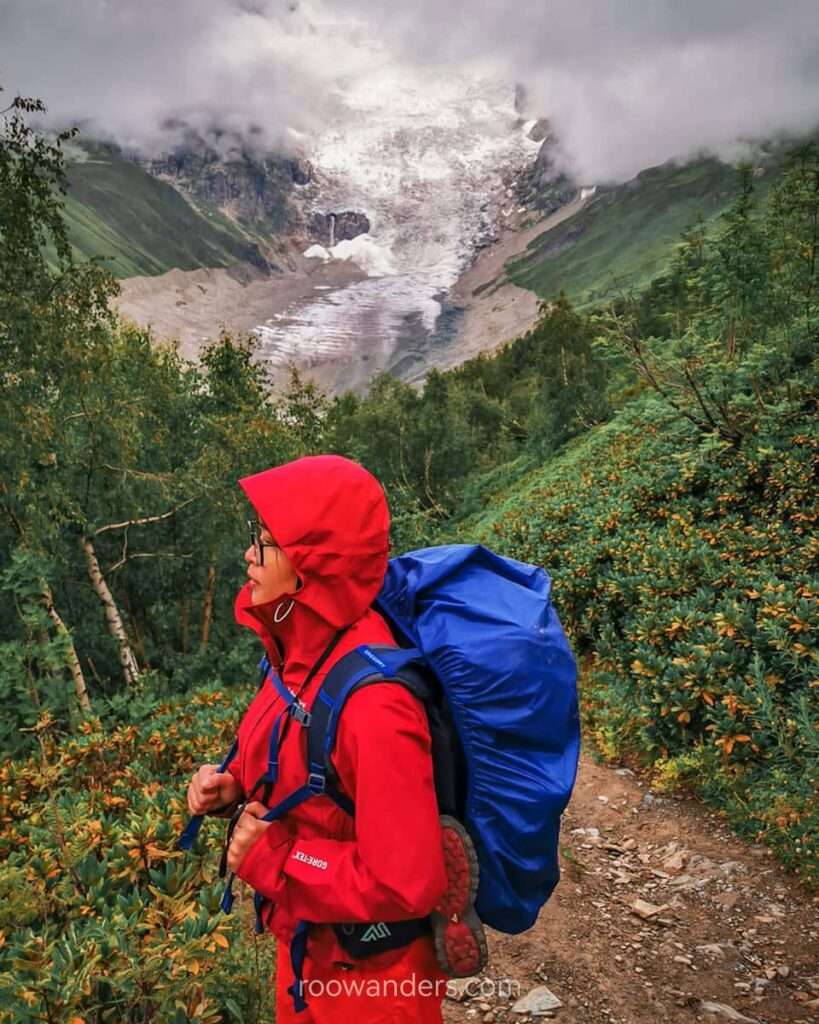
Conclusion and Rambles
Tbilisi is a delightful city to base in before you explore the rest of Georgia. It’s easy to move around, has enough attractions to keep you entertained for days, delicious and affordable food and alcohol to sample away, and most importantly, safe for solo travellers.
But alas, I have only this much time to travel in this part of the world. But I’m still glad to have walked down the streets of Old Tbilisi and enjoyed their hearty stews and kinkalis.
Having spent 2 years in New Zealand on a Working Holiday visa, I visited NZ extensively for the mountains, the yummy food, the culture, and the experience of working on farms I’ll never be able to in Singapore.
If ever I could have another year off again, spending a year in Georgia to slow-travel would have been another life-changing experience✨. I’ll have never-ending activities and places to explore! Delicious stew and soups! Mountains packed full of adventures! And culture and architecture so old they feel magical!
Oh, and lots of posts and photos to report back to you! 😉
Till then!
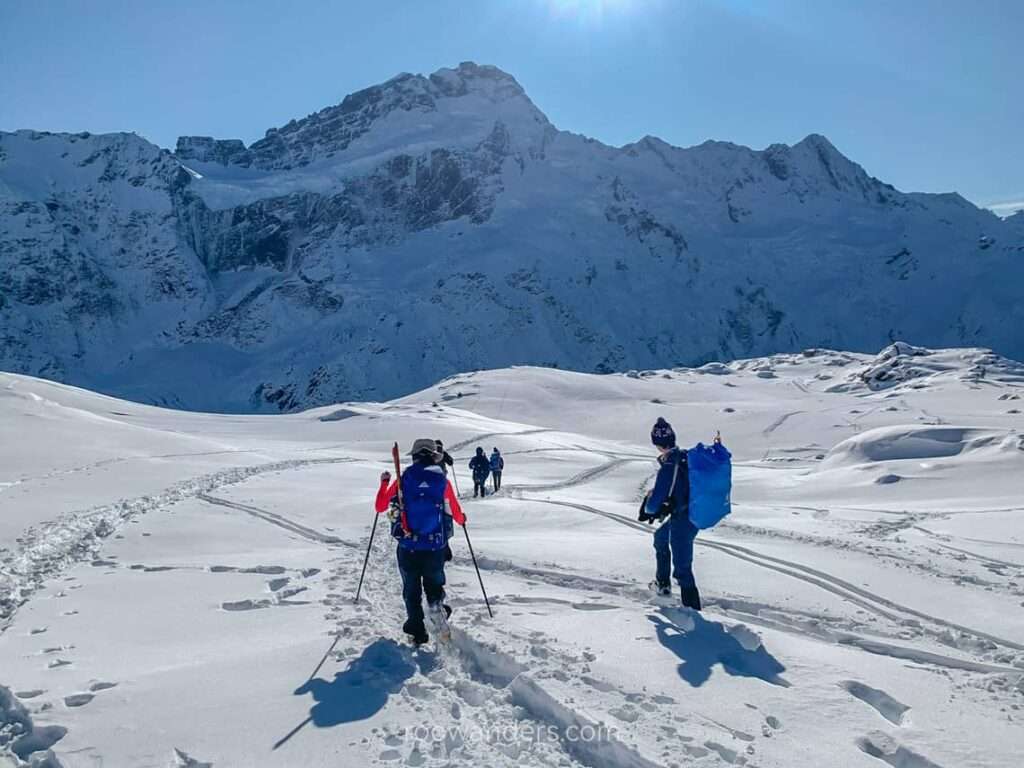
More Pointers for a great Tbilisi Trip
- Money. They use Lari/ GEL, but most places in Tbilisi accept international cards. Keep a few lari. Then again, travelling has been made even easier with cards like Wise. You could get cash from an ATM or waive your Wise card for contactless payment. If you’re based in Singapore, Trust is the credit card I’ll use (promo code: SURW9MK5). If you’re visiting remote towns or villages elsewhere in Georgia, cash is still the king.
- Water. You can drink tap water. I dislike the taste of tap water, so I usually boil my water before consumption or fill my bottle from the hostel. Sometimes drinking water fountains are available in the squares or places of worship.
- Download Bolt or Yandex. It’s like Grab or Uber. Call for a taxi through those apps rather than hail directly from the streets, where you set yourself up for rip-offs.
- Get a MetroMoney card. Unless you’re staying long in Tbilisi, then get the subscription-based Travel Card for unlimited metros and buses. The MetroMoney card can be used in many places.
- Book your sulfur hot baths early. They are on the must-do lists of many travellers. Check out my ✨comprehensive✨ post to understand how it goes in the dome-shaped baths.
- Book your accommodations and trains early. Especially if it is the peak travel season in Europe. I usually head over to booking or 12Go to solve my problems.
- Book your tours. I’ve used local tours in Tbilisi, and the experience wasn’t good. Operators from GetYourGuide have a reputation to uphold, and their prices are fair.





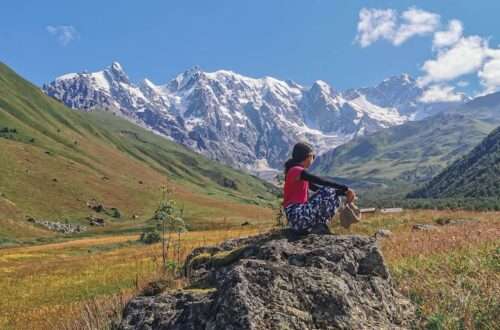
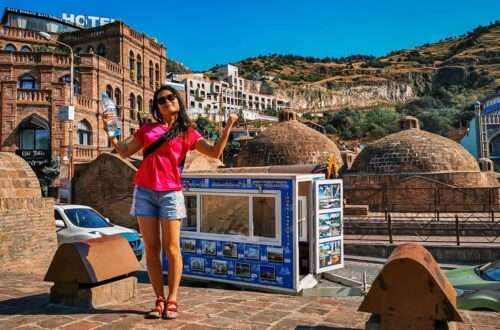
2 Comments
Yuxuan (River Valley High School)
Hello RooWanders! We are a group of Secondary 4 students from River Valley High School. We are currently embarking on a school project, focusing on the topic of work exchange. We believe that through your experience from around the world and fascinating stories, it would greatly be beneficial in allowing us to deepen our understanding towards this topic, designing pages of a magazine to share your unique story, captivating the power of adaptability. We sincerely hope that you can accept our interview request, may I have your email address to continue following up with our interview questions, thank you!
Roo
Hey Yuxuan, could you reach out to me via IG PM? We can discuss further from there. Cheers!